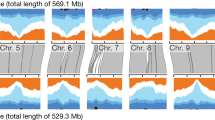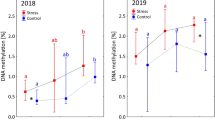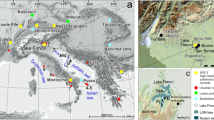Abstract
Sixteen enzymatic loci of Cepaea nemoralis were studied in an area of 180 km long by 40 km wide in northern Spain. Two new polymorphic loci DIA and GLO, and two monomorphics, ARYL and β-GAL are described.
The analysis of principal components groups the populations in two geographical areas, in the north and south of the sampling area. There is also an intermediate area between them. Heterozygosity in the northern area is significantly higher than in the southern one. Heterozygosity seems to diminish in unfavourable conditions (greater dryness or greater altitude), which is in accordance with the niche width variation hypothesis. There seems to exist an association between alleles of GLO and PGM and altitude.
The geographical areas created by the biochemical polymorphism coincide with those of the visible polymorphism, which in turn correspond to climatic zones. The northern area, according to visible and biochemical polymorphism is located in the so-called “Green Iberia”, and the southern area in “Brown Iberia”. The intermediate area corresponds to the area of climatic transition between them. These areas could correspond to “geographical races” of Cepaea nemoralis.
Climatic selection may be acting upon some loci such as PGM and GLO while in others random drift could be the cause of heterogeneity.
Similar content being viewed by others
Article PDF
References
Brussard, P F, and Mccracken, G F. 1974. Allozymic variation in a North American colony of Cepaea nemoralis. Heredity, 33, 98–101.
Cain, A J, and Currey, J D. 1963. Area effects in Cepaea on the Larkhill artillery ranges, Salisbury Plain. J Linn Soc (Zool), 45, 1–15.
Caugant, D, Selander, R K, and Jones, J S. 1982. Geographic structuring of molecular and morphological polymorphism in Pyrenean populations of the snail Cepaea nemoralis. Genetica, 57, 177–191.
Harris, H, and Hopkinson, D A. 1976. Handbook of Enzyme Electrophoresis in Human Genetics. North-Holland, Amsterdam.
Johnson, M S. 1976. Allozymes and area effects in Cepaea nemoralis on the Western Berkshire Downs. Heredity, 36, 105–121.
Johnson, M S. 1979. Inheritance and geographic variation of allozymes in Cepaea nemoralis. Heredity, 43, 137–141.
Jones, J S, Leith, B H, and Rawlings, P. 1977. Polymorphism in Cepaea: A problem with too many solutions? Ann Rev Ecol Syst, 8, 109–143.
Jones, J S, Selander, R K, and Schnell, G D. 1980. Patterns of morphological and molecular polymorphism in the land snail Cepaea nemoralis. Biol J Linn Soc, 14, 359–387.
Levan, G, and Fredga, K. 1972. Isozyme polymorphism in three species of land snails. Hereditas, 71, 245–252.
Manwell, C, and Baker, C M A. 1968. Genetic variation of isocitrate, malate and 6-phosphogluconate dehydrogenases in snails of the genus Cepaea. Introgressive hybridization, polymorphism and pollution? Comp Biochem Physiol, 26, 195–209.
Mazon, L I, M. Pancorbo, M A, Vicario, A, Aguirre, A I, Estomba, A, and Lostao, C M. 1987. Distribution of Cepaea nemoralis according to climatic regions in Spain. Heredity, 58, 145–154.
Nevo, E, Bar-El, C, Beiles, A, and Yom-Tou, Y. 1982. Adaptive microgeographic differentiation of allozyme polymorphism in land snails. Genetica, 59, 61–67.
Nevo, E, Beiles, A, and Ben-Shlomo, R. 1984. The evolutionary significance of genetic diversity: Ecological, demographic and life history correlates. In Mani, G. S. (ed.) Evolutionary Dynamics of Genetic Diversity, Springer-Verlag. Berlin, pp. 13–213.
Ochman, H, Jones, J S, and Selander, R K. 1983. Molecular area effects in Cepaea. Proc Natl Acad Sci USA, 80, 4189–4193.
Ochman, H, Jones, J S, and Selander, R K. 1987. Large scale patterns of genetic differentiation at enzyme loci in the land snails Cepaea nemoralis and Cepaea hortensis. Heredity, 58, 127–138.
Oxford, G S. 1973. The genetics of Cepaea esterases. I. Cepaea nemoralis Heredity, 30, 127–139.
Selander, R K, Smith, M H, Yang, G Y, Johnson, W E, and Gentry, J B. 1971. Biochemical polymorphism and systematics in the genus Peromyscus I. Variation in the old-field mouse (Peromyscus polionotus). Studies in Genetics, 6, 49–90.
Selander, R K, and Kaufmann, D W. 1975. Genetic structure of populations of the brown snail (Helix aspersa). I. Microgeographical variation. Evolution, 29, 385–401.
Selander, R K, and Ochman, H. 1983. The genetic structure of populations as illustrated by molluscs. In Isozymes: Current Topics in Biological and Medical Research, Vol. 10. Alan, New York, pp. 93–123.
Valdez-Forsans, M. 1983. Variabilité enzymatique dans les populations du Mollusque Cepaea nemoralis (L.) de la vallée de Ariege, Pyrénées francaises. CR Acad Se Paris, 296, 1045–1047.
White, M J D. 1978. Modes of Speciation. W. H. Freeman, San Francisco.
Wright, S. 1978. Evolution and Genetics of Populations, vol IV, Variability Within and Among Natural Populations. Univ. of Chicago Press. Chicago.
Author information
Authors and Affiliations
Rights and permissions
About this article
Cite this article
Mazon, L., Vicario, A., de Pancorbo, M. et al. North/South differentiation in the distribution of Cepaea nemoralis in Spain. Heredity 61, 189–197 (1988). https://doi.org/10.1038/hdy.1988.105
Received:
Issue date:
DOI: https://doi.org/10.1038/hdy.1988.105
This article is cited by
-
The genetic dynamics of the rapid and recent colonization of Denmark by Arion lusitanicus (Mollusca, Pulmonata, Arionidae)
Genetica (2011)
-
Geographical variation in shell morphology and isoenzymes of Helix aspersa Müller, 1774 (Gastropoda, Pulmonata), the edible land snail, from Greece and Cyprus
Heredity (1994)
-
Allozyme variation in populations of Cepaea nemoralis from Northern Spain
Heredity (1989)



